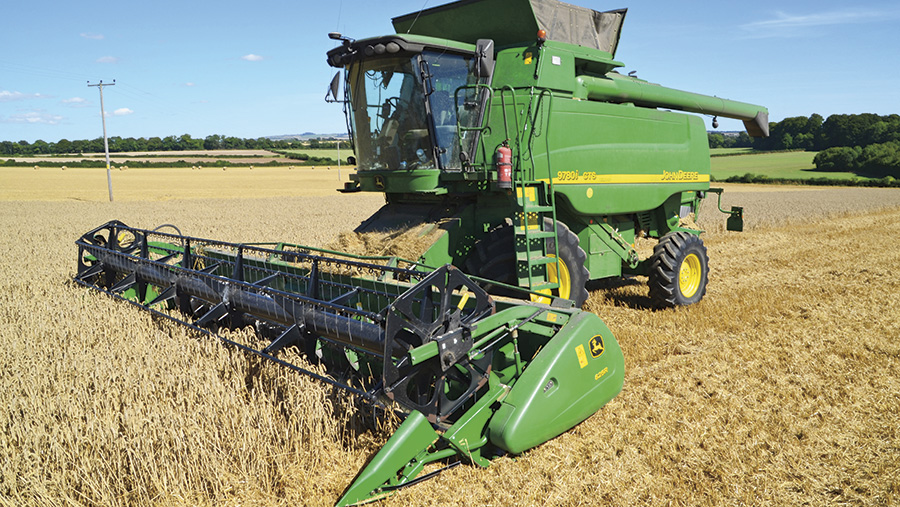Driver’s view: John Deere CTS 9780i combine
A large output when crops are at their driest was key for Dorset farmer James Reed.
After doing his research, the hybrid arrangement of the John Deere CTS was the system of choice when it came to upgrading the harvester.
After the old combine’s shaker shoe broke up, the farm was forced into changing, and a CTS 9780i arrived in the yard for the oncoming harvest.
Five years later, we see if the machine has proved itself and if the hybrid system is still the right one for them.

John Deere CTS 9780i © Nick Fone
See also: Top tips for starting a new farm contracting business
Why a John Deere CTS?
“Up until 2011 we had been running a John Deere 2064 but it had done 3,000 hours and was beginning to be unreliable.
Farm facts
- ND Dibben Farms, near Blandford, Dorset
- Farmed area 400ha. Varied soils from light chalk to clay cap with flints
- Cropping Winter wheat, spring barley, winter barley, OSR, spring beans
- Livestock 20 Angus-cross sucker cows and calves
Machinery
- Tractors Case IH MX170 and Puma 215
- Loader JCB TM320-S
- Combine John Deere CTS 9780i with 7.5m (25ft) header
- Sprayer 2,900-litre Amazone front and rear-mounted tanks with 24m booms
- Drill, Amazone Cayena 6001-C Seed and fert 6m drill
“It had injector issues and the shaker shoe broke up.
“We took that as a sign there might be more trouble on the way so we decided a change was sensible.
“We wanted extra capacity to cut crops at their driest and the CTS’s combination of a conventional drum up front with twin rotors in the rear offered that – it’s pretty much like a Lexion in design.
“The big advantage was that Deere offered full-body levelling with the HillMaster, which could make a difference on some of our steeper fields.”
What’s it capable of?
“In good standing wheat the CTS will easily churn out 30-35t/hour. When we’re chopping straw it drops back a bit – the main limiting factor is power.
“In damp, green straw we deliberately slow up to make sure the crop is properly threshed, just as we would with the old straw-walker machine.
“In fact, straw quality is never an issue – we’ve never once had a complaint from baling contractors and keep some straw for our own livestock.”
Is the chopper any good?
“The chopper runs all the time whether you’re swathing or chopping.
“That way whatever comes off the chaff pan gets spread to the full width which makes good sense.
“When we channel the straw through it, it generally makes a good job and being able to adjust the left-to-right bias from the cab is brilliant in avoiding material being thrown into the next bout of crop.”
Cab and controls?
“Although there are standard crop settings, Hunts also issue recommendations tailored to our local area which are generally bang on.
“They are incredibly knowledgeable on how best to set up a CTS – I can just phone our fitter and he will talk me through most things over the phone.”
Likes and gripes
Likes
- Narrow chassis – easy to move
- High output – can pick and choose to cut crops at their driest
- HillMaster – full body levelling maintains output across slopes
- Pre-cleaner – draws crop direct from drum to clean grain maximising output
Gripes
- Prone to fires – has a tendency to trap around exhaust
- Unloading auger sock – too short to stop losses of small seeds such as grass and OSR
- Cooling – radiators require daily blow out
What did it cost?
“We paid £89,000 for the CTS with 1,200 drum hours on the clock.
“Hunts had a choice of machines they had maintained and that really gave us confidence.
“We then spent a further £7,500 on a nearly new Zurn rape extension and side-knives.
“It’s dead easy to fit – four over-centre latches, a couple of skids and a belt.
“Cutting rape with it is much easier, with the extra table depth allowing more use of the reel than usual.”
Reliable?
“It came with a full service history and we get Hunts to do a major service each year so we hope they’ll pick up on anything we don’t see.
“That seems to have paid off as we’ve had very little go wrong over the past five harvests.
“Initially we had some issues with an oil pressure sensor but the parts came overnight and we were up and running the next day.
“This season we’ve had a threshing sensor play up but it hasn’t stopped us.”
Would you have another?
“I really like the CTS concept – it’s such a shame that Deere doesn’t build them any more.
“We get the output and, despite it using rotors, it keeps going in the damp.
“For now everything is running fine and we’d expect to easily get another couple of years work out of it.
“We’ll probably swap it in eventually for a fresher version of the same thing – something like a C670i if the right machine is available.”
Vital statistics
- 2007 model on 2,188 engine hours
- Hybrid drum and twin-rotor threshing
- 355hp John Deere engine
- 7.5m (25ft) header
- 10,000-litre grain tank
- HillMaster body levelling
- Made in Germany

